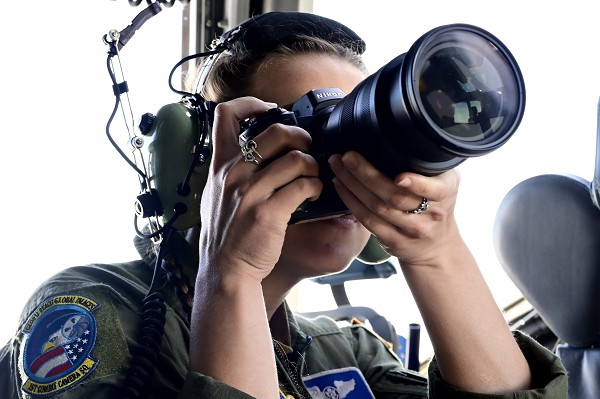
Charleston, North Carolina. (March 31, 2023): In this photo by Master Sergeant Matthew Plew, Airman 1st Class Natalie Vandergriff, an aerial combat camera journeyman, snaps actions photos during mobility force training missions over Charlotte, North Carolina. The 1st Combat Camera Squadron is the only active-duty combat camera unit in the Air Force that acquires imagery, both classified and not, for commanders and decision-makers in the field.
The Air Force Combat Camera Journeyman has played a courageous role recording military operations throughout the world. The images captured by these ordinary servicemembers have become some of the most iconic scenes of American at war. In addition to the deadly serious business of collecting classified information, the work of combat photographers helps shape both the image and public support for our nation’s military.
The story of the combat camera operators began during World War I when American Airmen flew some 35,000 hours capturing over 18,000 images of enemy positions. These primitive reconnaissance flights allowed American forces to “look over the horizon” to identify and target enemy formations, something that would prove vital to winning the war.
As the need for photographic intelligence assets grew, the Army established a photographic section within the US Army Signal Corps. During World War II, fourteen US Army Air Force Combat Camera Units provided still and motion picture coverage of the war in every theater of operations. Their visual record was vital for operational analysis, training, public information, and as a permanent historical record.
Today’s combat photographers can trace their roots to the Viet Nam War and the explosion of both still and film coverage of live combat. By 1967, the Air Force alone had over five hundred professionally trained photographic cinematographers documenting American war efforts throughout Southeast Asia. During the past 30 years, combat camera crews have filmed action during Desert Storm/Desert Shield, peacekeeping efforts in Bosnia and Herzegovina, Operation Iraqi Freedom, and Operation Enduring Freedom in Afghanistan.
To become an Air Force Combat Camera Journeyman, candidates must pass Basic Training and then train to be a photojournalist at the Defense Information School at Fort Meade, Maryland. This intellectually demanding 60 day crash course in journalism and public affairs includes laboratories on still photography, film processing & editing, and on-camera skills for military broadcasters. The school is open all service branches and its graduates provide news and features to the troops around the word.


